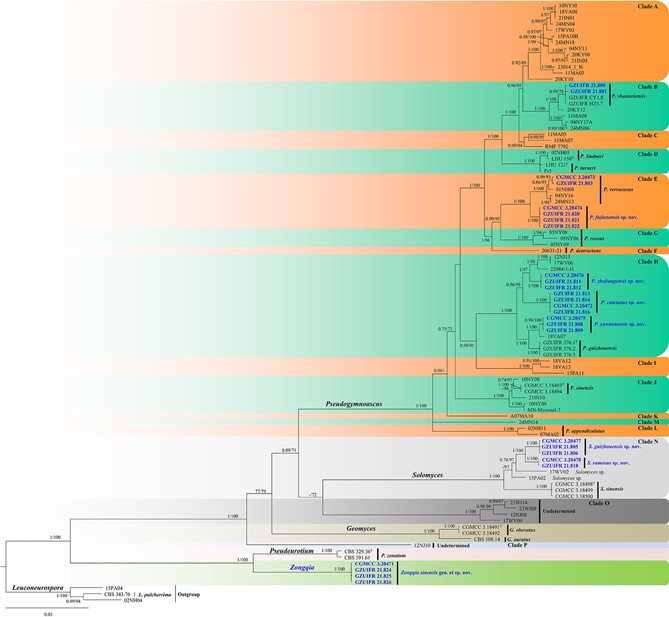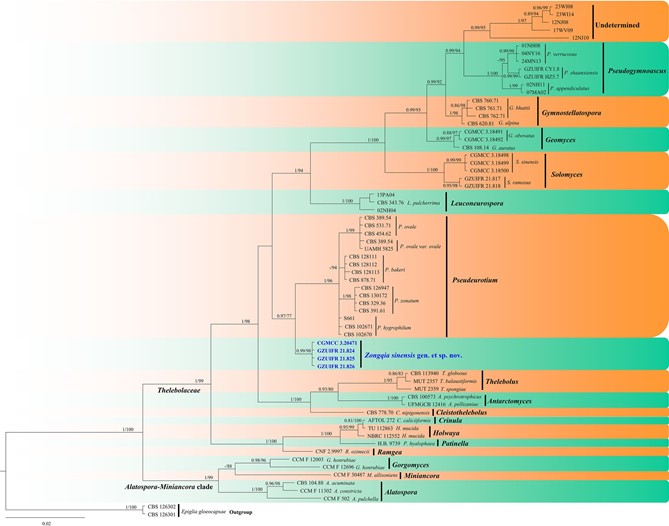Zongqia Zhang and Han, gen. nov.
MycoBank number: MB 840447; Index Fungorum number: IF 840447; Facesoffungi number: FoF14382;
Typification: Zongqia sinensis Zhang and Han.
Etymology: in honor of Zong-Qi Liang, acknowledging his contributions to our group.
Diagnosis: in addition to the phylogenetic distinctions (Fig. 1 to 2), Zongqia differs from Pseudeurotium by the presence of chains of conidia, conidiophores degenerated into conidiophore cells, clavate conidiophores cells. Description. Saprobic on the soil. Sexual morph: not observed. Asexual morph: hyphae branched, septate, smooth. Conidiophores not observed and were degenerated into conidiophore cells. Conidiophores cells hyaline, cylindrical, clavate, occurring directly from the hyphae, smooth-walled, solitary. Conidia aseptate, smooth-walled, one-celled, solitary or chains, obovate, subglobose, fusiform, cylindrical, clavate. Chlamydospores not observed.
Notes: The new genus Zongqia is introduced here based on phylogeny and morphological evidence. Until now, the Thelebolales consisted of 23 genera (22, 28). In five-loci (ITS, LSU, MCM7, RPB2, and EF1A; Fig. 1) and two-loci (ITS and LSU; Fig. 2) phylogenetic analyses, Zongqia was related to Pseudeurotium with high support values (1 PP/100% BS). However, because no ITS, LSU, MCM7, RPB2, and EF1A sequence data were reported for Ascophanus, Ascozonus, Caccobius, Coprobolus, Leptokalpion, Neelakesa, and Pseudascozonus (22), we could not compare the phylogenetic relationships between these genera and Zongqia. Morphologically, because there is no record of the asexual stage of Ascophanus, Ascozonus, Caccobius, Coprobolus, Leptokalpion, Neelakesa, and Pseudascozonus in the literature (29), we could not compare the morphology between these genera and Zongqia. Of the remaining genera, Zongqia is similar to Pseudeurotium, but there are still noteworthy differences between them. Zongqia is distinguished from Pseudeurotium by the presence of chains of conidia, conidiophores degenerated into conidiophore cells, clavate conidiophores cells, and no observed sexual morph.

FIG 1 Bayesian inference strict consensus tree illustrating the phylogeny of new taxa and related species in Thelebolales based on a five-loci (ITS, LSU, MCM7, RPB2, EF1A) concatenated data set. Branches are labeled with Bayesian posterior probabilities of .0.70 and maximum likelihood bootstrap values of .70%. The new taxa and strains are in bold and blue. Clade names follow previous studies (21, 24).

FIG 2 Bayesian inference strict consensus tree illustrating the phylogeny of genera in Thelebolales based on a two-loci (ITS and LSU) concatenated data set. Branches are labeled with Bayesian posterior probabilities of .0.70 and maximum likelihood bootstrap values of .70%. The new taxa and strains are in bold and blue.
Species
